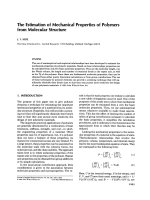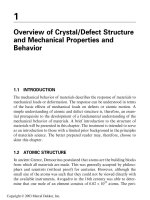Mechanical properties of polymers, composites-Nielsen 2010 Part 7 docx
Bạn đang xem bản rút gọn của tài liệu. Xem và tải ngay bản đầy đủ của tài liệu tại đây (311.36 KB, 10 trang )
Elastic Moduli 53
The morphology of the crystallite structures present is also important
in determining the mechanical properties.
D. Copolymerization and Plasticization
Plasticizer and Copolymerization change the glass transition temperature
as discussed in Chapter 1. Plasticixers have little effect on £„„. Copoly-
merization can change £
(
,
A
,, although less strongly than 7'
x
. As a result, the
basic modulus-temperature and modulus-time curves are shifted as shown
in Figure 8 for different compositions. The shift in the modulus-temper-
ature curve is essentially the same as the shift in T
K
. The shift in the
modulus-time curve includes this plus the effect of any change in £
()jr
Copolymers and plasticized materials often show another effect—a
broadening of the transition region with a decrease in the slope of the
modulus curve in the region of the inflection point. This effect is most
pronounced with plasticizer which are poor solvents for the polymer (80-
84). Heterogeneous copolymers, in which there is a change in overall
chemical composition in going from one molecule to another, also have
broad transition regions (85-87). This heterogeneity can result from the
fact that in most copolymerizations the first polymer formed terrds to be
richer in one component than the other, while during the last part of the
polymerization reaction the molecules become richer in the other co-
monomer. This results in a mixture with a distribution of glass transitions
and friction factors. Polymer mixtures of different chemical composition
tend to be insoluble in each other, and this tendency for phase separation
is another cause of the broadening of the transition region (87). If the
molecules of different composition are completely soluble in one another
and if the mixture is homogeneous in the sense of being thoroughly mixed,
there is little if any broadening of the transition (88).
The magnitude of the rubbery modulus does not depend, strictly speak-
ing, on M
f
but on the number concentration of chains between entangle-
ment points, v
r
(v,, = \>RTIM
r
). Thus plasticizers can lower the plateau
modulus by a simple dilution effect. Usually, the plasticizer content is too
low to have any significant effect. However, the plateau can be decreased
markedly within a polymer family (e.g., methyl acrylates) by copolymer-
izing a monomer with long side-chain branches (e.g., dodecyl methacry-
late). The decrease occurs because the degree of polymerization between
available cross-links />,.( = AVmotiomer molecular weight M
{)
) is insensitive
to structure (62) and nearly constant. Hence increasing M
o
raises the ef-
fective M
e
significantly, with a corresponding decrease in the rubbery plateau.
Plasticizers and Copolymerization also shift the glass transition responses
of the amorphous phase of crystalline polymers. In addition, the degree
of Crystallinity and melting point are lowered. The resulting effects on the
modulus-temperature curves are as expected from the previous discussion.
There are also other subtle effects, which are discussed in detail in later
chapters.
E. Block and Graft Polymers and Polyblends
In a few cases mixtures of two polymers are soluble in one another, where
there is a close match of the solubility parameters or strong polymer-
polymer interactions. They form single-phase systems. Two examples of
compatible blends are polystyrene with poly(2,6-dimethyl phenylene oxide)
(89) and poly(methyl methacrylate) with highly chlorinated (>50%) poly-
ethylene (90). The mechanical properties of compatible blends resemble
those of random copolymers, having a single T^ value and modulus tran-
sition zone. T
K
varies rather regularly with composition, often following
the simple rule of mixtures. The rubbery plateau and steady-flow viscosity
are less apt to vary regularly.
Generally, however, mixtures of two polymers arc insoluble in one
another and form two-phase systems (91-104). Block and graft polymers, in
Elastic Moduli 55
which there are long sequences of each homopolymer, also are two-phase
systems (105-114). Thus in block and graft polymers there is the unique
situation in which a single molecule can be in two phases simultaneously.
Incompatibility and phase separation can be difficult to determine. Most
often the inhomogeneity renders the product turbid or at least milky.
However, systems with closely matching indices of refraction or with a
very small domain size can be quite transparent. While differential scanning
calorimetry, density, dilatometric 7^, dielectric, and x-ray measurements
have all been applied to determining compatibility, modulus measurements
and scanning electron microscopy (ia cases where one phase can be stained)
have proven to be the most sensitive to phase separation (115). In two-
phase systems where the phases are well separated, there are two glass
transitions instead of the usual one. Each transition is characteristic of one
of the homopolymers. The resulting modulus-temperature curve has two
steep drops, as shown in Figure 9. The value of the modulus in the plateau
region between the two glass transitions depends on the ratio of the com-
ponents and on which phase tends to be the continuous phase and which
is the dispersed phase, and on the morphology of the discontinuous phase
56 Chapter 2
(104,116,117). A corresponding isothermal log E{t) versus log t plot would
look very similar if it could be measured over the full glass-to-flow region.
However, the width of the intermediate plateau would decrease strongly
with increasing temperature.









